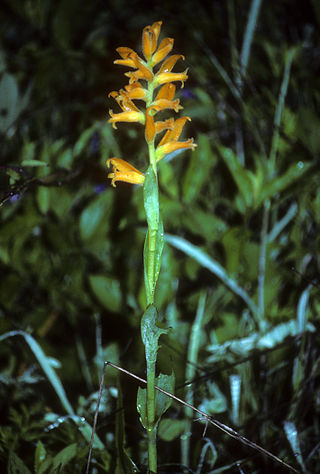
The taxonomy of the Orchidaceae (orchid family) has evolved slowly during the last 250 years, starting with Carl Linnaeus who in 1753 recognized eight genera. De Jussieu recognized the Orchidaceae as a separate family in his Genera Plantarum in 1789. Olof Swartz recognized 25 genera in 1800. Louis Claude Richard provided us in 1817 with the descriptive terminology of the orchids. (See External links below). The next step was taken in 1830-1840 by John Lindley, who recognized four subfamilies. He is generally recognized as the father of orchid taxonomy. The next important step was taken by George Bentham with a new classification, recognizing subtribes for the first time. This classification was first presented in a paper that Bentham read to the Royal Society in 1881. Then it was published in 1883 in the final volume of Genera Plantarum. The next great contributors were Pfitzer (1887), Schlechter (1926), Mansfeld (1937), Dressler and Dodson (1960), Garay (1960, 1972), Vermeulen (1966), again Dressler (1981). and Burns-Balogh and Funk (1986). Dressler's 1993 book had considerable influence on later work.

The Orchidoideae, or the orchidoid orchids, are a subfamily of the orchid family (Orchidaceae) that contains around 3630 species. Species typically have a single (monandrous), fertile anther which is erect and basitonic.

Spiranthes is a genus of orchids in the subfamily Orchidoideae. They are known commonly as ladies tresses, ladies'-tresses, or lady's tresses. The genus is distributed in the Americas, Eurasia, and Australia. The genus name Spiranthes is derived from the Greek speira ("coil") and anthos ("flower"), and was inspired by the spirally arranged inflorescence.

Satyrium is a genus of orchid. The Kew plant list for 2010 listed 85 full species as accepted, ignoring synonyms, subspecies and hybrids etc. About ten were still unresolved at the time. Most of the species occur in sub-Saharan Africa and Madagascar. The ranges of four species extend to Asia, mainly in India and Sri Lanka. Hybridization occurs between several species, complicating molecular phylogenetic studies, especially those relying on mitochondrial and chloroplast DNA sequences.

Disperis is a genus of plants in the orchid family, Orchidaceae. It has about 78 species. Most of the species are from tropical and southern Africa, as well as Indian Ocean islands. A few are native to the tropical or the warmer subtropical regions of Asia and Malesia.
Tsaiorchis is a genus of flowering plants in the family Orchidaceae.

Catasetinae is a subtribe within the Orchidaceae and contains 8 genera. Its members are widespread in lowland tropical Central and South America up to 1,500 meters. They are found on trees, stumps or old fence posts.

Beloglottis is a genus of the family Orchidaceae. This genus belongs to the tribe Cranichideae and subtribe Spiranthinae. Orchids of the genus Beloglottis are terrestrial sympodial plants that can be used as herbal supplements. They have short, solitary stems that stand erect and the fleshy roots contain small hair-like projections and are arranged in a fascicle. Several leaves containing a petiole form at the base of the plant. The flowers appear as if they are upside down.
An alliance is an informal grouping used in biological taxonomy. The term "alliance" is not a taxonomic rank defined in any of the nomenclature codes. It is used for any group of species, genera or tribes to which authors wish to refer, that have at some time provisionally been considered to be closely related.

Dichromanthus is a genus of flowering plants from the orchid family, Orchidaceae. As currently delimited, it is monophyletic and includes four species:
- Dichromanthus aurantiacus(Lex.) Salazar & Soto Arenas - much of Mexico, south to Honduras
- Dichromanthus cinnabarinus(Lex.) Garay - from Texas to Guatemala
- Dichromanthus michuacanus(Lex.) Salazar & Soto Arenas - from Texas and Arizona south to Honduras
- Dichromanthus yucundaaSalazar & García-Mend. - Oaxaca

Discyphus is a genus of flowering plants from the orchid family, Orchidaceae. It is the only genus in the subtribe Discyphinae of the tribe Cranichideae. It contains only one currently recognized species, Discyphus scopulariae, with two accepted varieties:

Eurystyles is a genus of flowering plants from the orchid family, Orchidaceae. It contains over 20 known species native to South America, Central America, the West Indies and Chiapas.
- Eurystyles actinosophila(Barb.Rodr.) Schltr.
- Eurystyles alticolaDod
- Eurystyles ananassocomus(Rchb.f.) Schltr.
- Eurystyles borealisA.H.Heller
- Eurystyles christensoniiD.E.Benn.
- Eurystyles cogniauxii(Kraenzl.) Schltr.
- Eurystyles cornu-bovisSzlach.
- Eurystyles cotyledonWawra
- Eurystyles cristata(Schltr.) Schltr.
- Eurystyles crocodilusSzlach.
- Eurystyles domingensisDod
- Eurystyles gardneri(Lindl.) Garay
- Eurystyles guentheriana(Kraenzl.) Garay
- Eurystyles hoehneiSzlach.
- Eurystyles lobataChiron & V.P.Castro
- Eurystyles lorenzii(Cogn.) Schltr.
- Eurystyles luisortizii
- Eurystyles ochyrana(Szlach., Mytnik & Rutk.) F.Barros & L.R.S.Guim.
- Eurystyles rutkowskianaSzlach.
- Eurystyles splendissimaSzlach.
- Eurystyles standleyiAmes

Galeottiella is a genus of flowering plants from the orchid family, Orchidaceae. Traditionally it had been included in subtribe Spiranthinae, but following molecular phylogenetic and morphological studies it is now placed in a subtribe on its own, Galeottiellinae.

Dendrobieae is a tribe in the subfamily Epidendroideae, in the family Orchidaceae. The Dendrobieae are mostly tropical, epiphytic orchids which contain pseudobulbs.

Cranichideae is an orchid tribe in the subfamily Orchidoideae.

Orchideae is a tribe of orchids in the subfamily Orchidoideae. Historically, it was divided into 2 subtribes, Orchidinae and Habenariinae. The subtribe Orchidinae alone contains about 1,800 species. However, although some phylogenetic studies have established the monophyly of the subtribes, the generic boundaries are unclear, with many genera as traditionally circumscribed being paraphyletic or even polyphyletic. Species of genera such as Habenaria and Platanthera have been placed into both subtribes. A 2017 molecular phylogenetic study found that both subtribes did form clades, but did not formally recognize Habenariinae, because of missing genera and uncertainty over generic boundaries. The Asian species of Orchideae, in particular, have been subject to repeated changes of generic placement from 2012 onwards.

Diseae is an orchid tribe in the subfamily Orchidoideae. It was recognized in Genera Orchidacearum volume 2, which was published in 2001. It consisted of 12 genera in five subtribes. In molecular phylogenetic studies that were published after 1999, it was shown that Diseae is paraphyletic over the tribe Orchideae. In a classification of orchids that was published in 2015, Diseae was not recognized, but was instead placed in synonymy under Orchideae.

Spiranthinae is an orchid subtribe in the tribe Cranichideae.

Galeoglossum is a genus of orchids native to Mexico and Guatemala.
Hemipilia pinguicula is a species of flowering plant in the family Orchidaceae. It is native to south-eastern China.

















